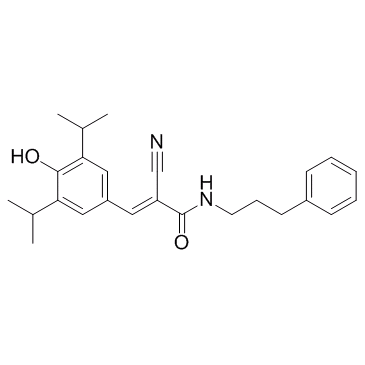| Description |
SU1498 is a selective inhibitor of the VEGFR2; inhibits Flk-1 with an IC50 of value of 700 nM.
|
| Related Catalog |
|
| Target |
Flk-1:700 nM (IC50)
|
| In Vitro |
SU1498 stimulates accumulation of phosphorylated ERKs in human umbilical vein endothelial cells and in human aortic endothelial cells in a manner that is dependent on the functioning of the upstream components of the MAPK pathway, B-Raf, and MEK kinases. The enhanced accumulation of phospho-ERKs is observed only in cells that have been stimulated with sphingosine 1-phosphate or protein growth factors; SU1498 by itself is ineffective[2]. SU1498 blocks signal transduction from VEGFR2 in MS1 VEGF cells.In the presence of SU1498, levels of Ets-1 are decreased, suggesting that VEGF-VEGFR-2 interactions contributed to baseline levels of Ets-1 expression, and interruption of this autocrine interaction with SU1498 led to decreased expression of Ets-1[3]. SU1498 treatment significantly impacts U87 cell proliferation and apoptosis. SU1498 induces a marked increase in lipids and a decrease in glycerophosphocholine. Accordingly, accumulation of lipid droplets is seen in the cytoplasm of SU1498-treated U87 cells[4].
|
| Kinase Assay |
The ERK1 or ERK2 solution is pipetted into tubes (1 μL per tube) and mixed with 0-10 μL of 50 μM SU1498 (in kinase buffer without ATP). The blank tube receives buffer only. The volume is adjusted to 11 μL with the same buffer, and the mixtures are incubated for 10 min at 25°C. This is followed by the addition of 40 μL of the Elk1-ATP-buffer solution, and the incubations are continued for 30 min at 30°C. The reactions are stopped with 20 μL of 4× sample buffer mix and heating at 95°C for 10 min. Samples (15 μL) are fractionated by SDS-PAGE, and phosphorylated Elk1 is detected by immunoblotting with anti-phospho-Elk1 antibody[2].
|
| Cell Assay |
For cell proliferation assay, U87 cells are seeded in 24-well plates (30,000 cells/well) and allowed to attach overnight. Cells are then treated for 24 or 72 h with different concentrations of Bevacizumab (from 10 ng/mL to 250 µg/mL) or SU1498 (from 1 µM to 30 µM) in triplicate wells. The cell viability is then assessed with the MTT assay[4].
|
| References |
[1]. Strawn LM, et al. Flk-1 as a target for tumor growth inhibition.Cancer Res. 1996 Aug 1;56(15):3540-5. [2]. Boguslawski G, et al. SU1498, an inhibitor of vascular endothelial growth factor receptor 2, causes accumulation of phosphorylated ERK kinases and inhibits their activity in vivo and in vitro.J Biol Chem. 2004 Feb 13;279(7):5716-24. [3]. Arbiser JL, et al. Overexpression of VEGF 121 in immortalized endothelial cells causes conversion to slowly growing angiosarcoma and high level expression of the VEGF receptors VEGFR-1 and VEGFR-2 in vivo.Am J Pathol. 2000 Apr;156(4):1469-76. [4]. Mesti T, et al. Metabolic impact of anti-angiogenic agents on U87 glioma cells.PLoS One. 2014 Jun 12;9(6):e99198.
|


